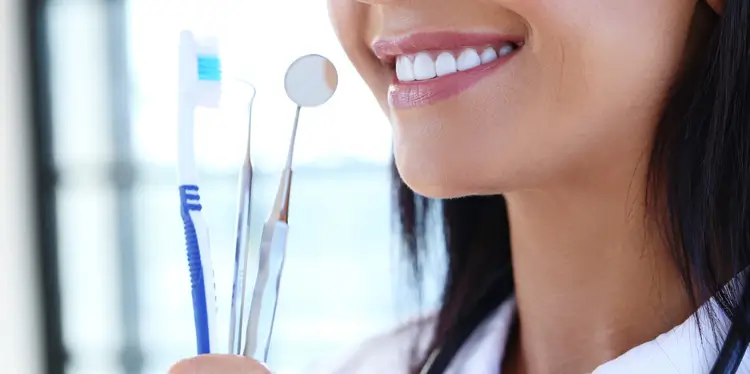Receding Gumlines and Oral Care: What Dental Treatment Options are Available?
Gum disease is extremely common amongst Australians. Whether it’s a result of poor dental hygiene, smoking, too much sugar or other factors, our gums can often suffer. One outcome is a receding gumline, which is not only unsightly but also severe for your overall dental health.
Continue reading to find out more about receding gums and what you can do to prevent them from happening to you.
What is a receding gumline?
A receding gumline is a condition in which your gums effectively start pulling back from the surface of your teeth. The major issue is that it exposes the roots of your teeth, which are more sensitive. This leads to sharp pain when consuming hot or cold foods.
This type of periodontal disease is actually a progressed form of gingivitis. It starts with a build-up of bacteria and tartar in both the gums and teeth. This tartar, if not managed correctly, eventually damages gums to the point that they begin pulling back from your teeth.
What causes receding gums?
Receding gums can be caused by many factors, but the most common is the bacteria and plaque build-up mentioned above. However, there are some other things that can affect your gums and lead to periodontal disease. Some common causes include:
· Brushing your teeth too hard, or using a toothbrush that is too hard for your gums
· Hardened plaque, as mentioned above, damages gums and makes them pull away
· Hormonal changes
· Diabetes
· HIV
· Smoking
· A family history of gum disease
In addition, a dry mouth means that your body isn’t producing enough saliva. Without enough saliva, your mouth is more susceptible to bacteria growth and other problems. So, anything that causes a dry mouth, such as smoking and certain medications, can be an underlying cause of receding gums.
Signs of a receding gumline
How do you know if you have issues with a receding gumline? Well, it’s not always particularly obvious because the process occurs slowly over many months and years. You may not notice any visible signs of recession early on, but there are a few other signs to look out for.
· Bad breath, which is also a sign of many other dental issues
· Bleeding after brushing your teeth
· Swollen or red gums
· Experiencing pain around the gumline
· Loose teeth
· Visibly receding gums
All of these can be signs of periodontal disease and should therefore be investigated as soon as possible. If you suffer from any of these symptoms, we recommend making an appointment with your local Parramatta dentist for a check-up at your earliest opportunity.
Can you fix a receding gumline?
There is some good and bad news on the treatment front when it comes to receding gums. While gum recession can’t be reversed, the cause of the gum recession can often be treated. This means the process of gum recession can essentially be stalled, or considerably slowed down. The first step is always a consultation with your dentist, and they will recommend treatment options.
Medication
In the instance of a bacterial infection causing the gum recession, your dentist can recommend medication to treat the infection. This may be with an antiseptic gel, antimicrobial mouthwash or another form of enzyme suppressant. Once the infection is treated, gum recession should slow down considerably.
Surgery
If your case of receding gums is severe enough, surgery may be the only option. Flap surgery, in particular, can have excellent results. Basically, the gums are lifted, almost like a flap, and cleaned thoroughly. It’s a deep tissue clean, removing bacteria and tartar build-up around the gums. The gums are then put back in place, and many people even feel that their teeth appear longer after this surgery.
The other option is grafting, in which an attempt is made to revive gum tissue or bone that has been damaged. This is done by using a synthetic particle or a piece of bone/tissue that helps the gums grow back.
With either of these surgical options, it’s important to note that you need to commit to taking care of your oral health for the long term. Without maintaining good dental hygiene, the surgery won’t work as intended, and you’ll be back to square one.
How to prevent receding gums
Since receding gums are mostly caused by bacteria and plaque building up on the teeth and gums, proper dental hygiene is the best way to prevent these issues. Of course, the basic tasks of brushing and flossing are the best place to start. These help to remove bacteria and plaque, keeping your mouth clean and free of infections.
However, tartar, which is the other main contributor to gum disease, cannot be removed with brushing alone. This can only be removed by a dental cleaning, so even if you don’t experience any pain or dental issues, you should book in for dental cleaning twice a year. This is your best safeguard against gum disease.
The other benefit of regular dental check-ups is that your dentist can spot the early signs of gum disease. If you can get on top of any bacterial issues or tartar build-up before you experience any visible signs of receding gums, the chances are good that you can nip it in the bud before it becomes an issue.
Contact Parramatta Dental today
As your leading dental clinic in Parramatta, we’re here to help with all aspects of oral and dental hygiene. If you are showing signs of a receding gumline, it’s important to speak to your dentist as soon as possible. Our Parramatta dentists can recommend a range of treatment options, while also caring for your overall dental health. Contact us today to find out how we can help.
Read Also:

